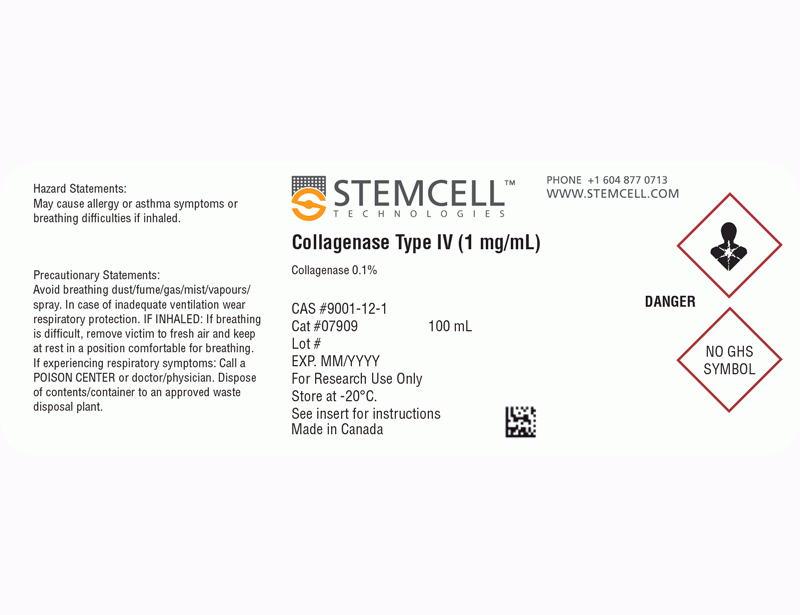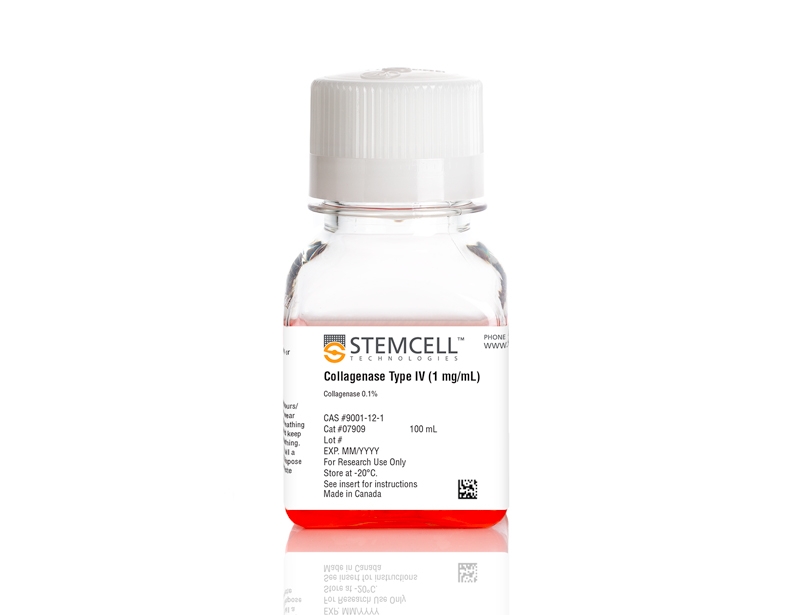Collagenase Type IV (1 mg/mL)
Cell dissociation reagent
概要
Human embryonic stem (ES) cells are routinely passaged as clumps, rather than single cells. To generate clumps appropriate for passaging, both enzymatic and mechanical (by dissection or scraping) methods can be used. Collagenase Type IV is an enzyme that is routinely used at 1 mg/mL for the generation of human ES cell and iPS cell clumps for passaging.
Contains
• 1 mg/mL Collagenase Type IV isolated from Clostridium histolyticum
• DMEM/F-12
• DMEM/F-12
Subtype
Enzymatic
Species
Human, Mouse, Rat, Non-Human Primate, Other
技术资料
| Document Type | 产品名称 | Catalog # | Lot # | 语言 |
|---|---|---|---|---|
| Product Information Sheet | Collagenase Type IV (1 mg/mL) | 07909 | All | English |
| Safety Data Sheet | Collagenase Type IV (1 mg/mL) | 07909 | All | English |
数据及文献
Publications (5)
Methods in molecular biology (Clifton, N.J.) 2016 FEB
A Concise Protocol for siRNA-Mediated Gene Suppression in Human Embryonic Stem Cells.
Abstract
Abstract
Human embryonic stem cells hold great promise for future biomedical applications such as disease modeling and regenerative medicine. However, these cells are notoriously difficult to culture and are refractory to common means of genetic manipulation, thereby limiting their range of applications. In this protocol, we present an easy and robust method of gene repression in human embryonic stem cells using lipofection of small interfering RNA (siRNA).
Nature communications 2014 SEP
Aneuploidy induces profound changes in gene expression, proliferation and tumorigenicity of human pluripotent stem cells.
Abstract
Abstract
Human pluripotent stem cells (hPSCs) tend to acquire genomic aberrations in culture, the most common of which is trisomy of chromosome 12. Here we dissect the cellular and molecular implications of this trisomy in hPSCs. Global gene expression analyses reveal that trisomy 12 profoundly affects the gene expression profile of hPSCs, inducing a transcriptional programme similar to that of germ cell tumours. Comparison of proliferation, differentiation and apoptosis between diploid and aneuploid hPSCs shows that trisomy 12 significantly increases the proliferation rate of hPSCs, mainly as a consequence of increased replication. Furthermore, trisomy 12 increases the tumorigenicity of hPSCs in vivo, inducing transcriptionally distinct teratomas from which pluripotent cells can be recovered. Last, a chemical screen of 89 anticancer drugs discovers that trisomy 12 raises the sensitivity of hPSCs to several replication inhibitors. Together, these findings demonstrate the extensive effect of trisomy 12 and highlight its perils for successful hPSC applications.
Cellular reprogramming 2014 OCT
Trisomy 21 mid-trimester amniotic fluid induced pluripotent stem cells maintain genetic signatures during reprogramming: implications for disease modeling and cryobanking.
Abstract
Abstract
Trisomy 21 is the most common chromosomal abnormality and is associated primarily with cardiovascular, hematological, and neurological complications. A robust patient-derived cellular model is necessary to investigate the pathophysiology of the syndrome because current animal models are limited and access to tissues from affected individuals is ethically challenging. We aimed to derive induced pluripotent stem cells (iPSCs) from trisomy 21 human mid-trimester amniotic fluid stem cells (AFSCs) and describe their hematopoietic and neurological characteristics. Human AFSCs collected from women undergoing prenatal diagnosis were selected for c-KIT(+) and transduced with a Cre-lox-inducible polycistronic lentiviral vector encoding SOX2, OCT4, KLF-4, and c-MYC (50,000 cells at a multiplicity of infection (MOI) 1-5 for 72 h). The embryonic stem cell (ESC)-like properties of the AFSC-derived iPSCs were established in vitro by embryoid body formation and in vivo by teratoma formation in RAG2(-/-), $\$-chain(-/-), C2(-/-) immunodeficient mice. Reprogrammed cells retained their cytogenetic signatures and differentiated into specialized hematopoietic and neural precursors detected by morphological assessment, immunostaining, and RT-PCR. Additionally, the iPSCs expressed all pluripotency markers upon multiple rounds of freeze-thawing. These findings are important in establishing a patient-specific cellular platform of trisomy 21 to study the pathophysiology of the aneuploidy and for future drug discovery.
Stem cell reports 2014 AUG
Doxycycline enhances survival and self-renewal of human pluripotent stem cells.
Abstract
Abstract
We here report that doxycycline, an antibacterial agent, exerts dramatic effects on human embryonic stem and induced pluripotent stem cells (hESC/iPSCs) survival and self-renewal. The survival-promoting effect was also manifest in cultures of neural stem cells (NSCs) derived from hESC/iPSCs. These doxycycline effects are not associated with its antibacterial action, but mediated by direct activation of a PI3K-AKT intracellular signal. These findings indicate doxycycline as a useful supplement for stem cell cultures, facilitating their growth and maintenance.
PLoS ONE 2014 APR
Rapid and efficient conversion of integration-free human induced pluripotent stem cells to GMP-grade culture conditions
Abstract
Abstract
Data suggest that clinical applications of human induced pluripotent stem cells (hiPSCs) will be realized. Nonetheless, clinical applications will require hiPSCs that are free of exogenous DNA and that can be manufactured through Good Manufacturing Practice (GMP). Optimally, derivation of hiPSCs should be rapid and efficient in order to minimize manipulations, reduce potential for accumulation of mutations and minimize financial costs. Previous studies reported the use of modified synthetic mRNAs to reprogram fibroblasts to a pluripotent state. Here, we provide an optimized, fully chemically defined and feeder-free protocol for the derivation of hiPSCs using synthetic mRNAs. The protocol results in derivation of fully reprogrammed hiPSC lines from adult dermal fibroblasts in less than two weeks. The hiPSC lines were successfully tested for their identity, purity, stability and safety at a GMP facility and cryopreserved. To our knowledge, as a proof of principle, these are the first integration-free iPSCs lines that were reproducibly generated through synthetic mRNA reprogramming that could be putatively used for clinical purposes.


